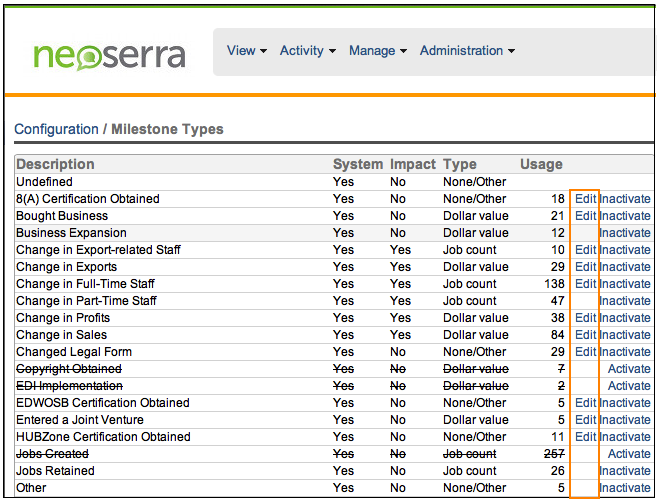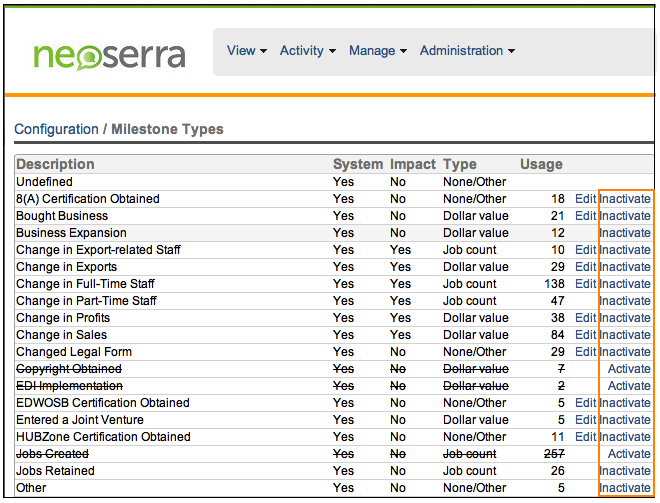How do I add, edit, or inactivate milestone types?
Neoserra comes with more than 30 built-in milestone types to help you track important events in a client's business cycle. In addition to the system defined milestones, you can also add your own milestone types. You can track Milestones by client by creating a milestone record for each client that has achieved a particular milestone. In this FAQ we will review:
- Add user-defined milestone types
- Edit milestone types
- Inactivate milestone types
Adding User-Defined Milestone Types to Milestone Records
User-defined milestone types can only be added by Neoserra administrators under the Configuration menu option as illustrated in the steps listed below. Keep in mind, that milestones are created globally within the Neoserra application, meaning that all milestones will be visible on the milestone record for all clients. In other words, you cannot make some milestones appear for some clients while making them disappear for other clients.
- Enter administrator-mode and select Administration|Configuration to open the global configurations interface.
- From the Configuration menu, click "Milestone Types."
- Scroll down the table of milestone types until you come to the first milestone type with a description of "(unused)" and click the corresponding "Edit" hyperlink that displays in the far right column.
- From the pop-up window that appears, enter a complete description (as it will display on the milestone interface) for the new milestone type into the Description field.
- In the Short description field, enter an abbreviated description for the new field. This abbreviation will display in columnar reports when there is not enough room for the full description.
- From the Amount type field's picklist, select the type of value the milestone will be tracking. There are three value types to choose from:
- Value. The "Value" selection should be chosen if you are tracking an ordinary numeric value (e.g. the expansion of distribution channels from 5 channels to 6)
- Currency. If your new milestone type is tracking currency amounts, select this value type.
- Job count. If your new milestone type is tracking a count of jobs, select this value type.
- None. The "None" selection should be chosen if you are not tracking a value at all (e.g. you are tracking the occurrence of an event such as a course completed or a certification obtained).
- The last three fields pertain to how (or even if) the new milestone type is included as a built-in question on your eCenter Direct surveys. If you don't anticipate the custom milestone ever being used as a survey question, you can ignore these three fields. If you do want to use the milestone type as a survey question, you'll need to complete one or more of them:
- Survey question. If you want to use this milestone type as a built-in survey question, enter the question text into this field. You should always phrase the question as a yes/no question because that is how the question displays on the survey, as shown in the following graphic. If you leave this field blank, then the milestone type cannot be used as a built-in question on your client surveys.
- Date label and Value label. These next two fields are optional. Depending upon the type of milestone you are capturing, it may be enough to simply have the client select the yes/no check box and leave it at that. For example, if the survey question is "Did you complete our "Getting Started" orientation?," and you only cared about whether or not the seminar was completed, you would leave both the Date label and Value label fields blank so that they do not display on the survey. But perhaps you also want to know when the orientation was completed, in which case you would enter something like "When did you complete this orientation?" into the Date label field. Taking it a step further, perhaps you also want to know how many people affiliated with the client's business completed the orientation, in which case you would enter something like "How many people in total completed this orientation?" into the Value label field.
- When you have completed the relevant fields for your custom milestone type, click the Save button.
Editing Milestone Types
You can edit all aspects of a custom milestone type, but this is not true for built-in milestone types. When editing a built-in milestone type, the only fields you have access to are those relating to the process of making the milestone available as a survey question.
To edit any milestone type, whether built-in or custom, follow the next set of steps:
- In administrator-mode, select Administration|Configuration to open the global configurations interface.
- From the Configuration menu, click "Milestone Types."
- Find the milestone type that you want to edit and click the corresponding "Edit" hyperlink that displays in the far right column. If there is no "Edit" hyperlink available for that milestone type, it means that it is a system milestone that is not intended to be included on surveys and therefore, there is nothing to edit.
- Make edits as appropriate and click the Save button.

If it's a custom milestone type, you can edit all aspects of it. If it's a built-in milestone type, the only fields you have access to are those relating to the process of making the milestone available as a survey question (these fields are discussed in step 8 in the previous section). How can you tell whether it's a built-in or custom milestone type? Built-in milestone types display a value of "Yes" under the "System" column whereas custom milestone types display a value of "No."
Important: Be careful when editing milestone types. All milestone records (and survey definition records) that currently reference that milestone type will be instantly updated with your edits. This means that if you change the meaning of a milestone type, you are potentially left with milestone records that no longer make any sense or that are misleading.
As a general rule, it's better to inactivate a milestone type and create a new one rather than edit an existing one to ensure that you preserve historical milestone data. To get an idea of the impact that a milestone edit may have, you can easily see how many records currently reference a milestone type from under the milestone table's "Usage" column.
Inactivating Milestone Types
When you inactivate a milestone type, rest assured that all records that reference that milestone will be preserved with that choice still in place. In fact, you'll still be able to run subsets on that type if you ever need to identify those records down the road. What changes is your ability to select an inactivated milestone type when creating new milestone records.
Follow these steps to inactivate a built-in or custom milestone type:
- In Neoserra, enter administrator-mode and select Anistration|Configuration.
- From the Configuration menu, click "Milestone Types."
- Find the milestone type that you want to inactivate and click the corresponding "Inactivate" hyperlink that displays in the far right column. If there is no "Inactivate" hyperlink available for that milestone type, it means that it is a system milestone that is not intended to be included on surveys and therefore, there is nothing to edit.
- The choice you just inactivated will now have a strike-out line running through it.

Note: If there is no "Inactivate" hyperlink available for that milestone type, it means that due to that milestone type's tight integration with other areas of Neoserra (namely the client/milestone synchronization global configuration), it cannot be inactivated.
Note: To reactivate the milestone type at a later date, simply return here and click the "Activate" hyperlink.
Want more? Browse our extensive list of Neoserra FAQs.
